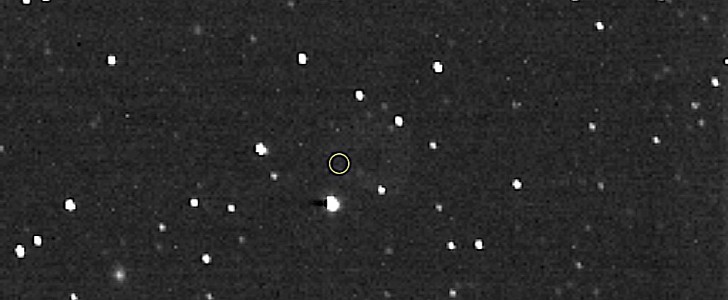Take a good long look at the photo accompanying this piece. There’s a yellow circle in the middle of the pic, surrounding a speck of black space—that’s where NASA says the Voyager 1 spaceship is located, as seen through the camera of another very distant explorer, New Horizons.
After more than half of century of space exploration, humankind has five spaceships heading out into interstellar space, and currently at a distance of at least 50 astronomical units from the Sun (that would be 50 times the distance between Sol and Earth). Those are Voyager 1, Voyager 2, Pioneer 1, Pioneer 2, and, as of April 17, 2021, New Horizons.
In numbers we can all understand, 50 astronomical units would be a distance of at least 5 billion miles (7.5 billion km), way, way into the depths of nothingness, where you’d think chances of one machine bumping into one of the other spacecraft are close to zero.
You’d think, but that is kind of what NASA says happened earlier this month. As it goes through the Kuiper Belt, New Horizons was capable of capturing an image of the star field where Voyager 1 currently is. That’s right, that would be in the middle of that yellow circle, and even if you don’t actually see anything in there, NASA says “its location is known precisely due to [...] radio tracking,” and that’s the spot.
The event marks the first time in history when a very distant spacecraft is photographed by another one some distance away, in the vastness of space.
New Horizons launched in 2006, heading for the outer edges of our solar system. In 2015 it reached the Pluto system, then at the very end of 2018, it approached Ultima Thule, a rock 30 kilometers (19 miles) in diameter and shaped like a peanut. In 2019, it made its first close encounter with a Kuiper Belt object, Arrokoth.
According to NASA, New Horizons will soon receive an update and is supposed to keep operating until well into the next decade.
In numbers we can all understand, 50 astronomical units would be a distance of at least 5 billion miles (7.5 billion km), way, way into the depths of nothingness, where you’d think chances of one machine bumping into one of the other spacecraft are close to zero.
You’d think, but that is kind of what NASA says happened earlier this month. As it goes through the Kuiper Belt, New Horizons was capable of capturing an image of the star field where Voyager 1 currently is. That’s right, that would be in the middle of that yellow circle, and even if you don’t actually see anything in there, NASA says “its location is known precisely due to [...] radio tracking,” and that’s the spot.
The event marks the first time in history when a very distant spacecraft is photographed by another one some distance away, in the vastness of space.
New Horizons launched in 2006, heading for the outer edges of our solar system. In 2015 it reached the Pluto system, then at the very end of 2018, it approached Ultima Thule, a rock 30 kilometers (19 miles) in diameter and shaped like a peanut. In 2019, it made its first close encounter with a Kuiper Belt object, Arrokoth.
According to NASA, New Horizons will soon receive an update and is supposed to keep operating until well into the next decade.

